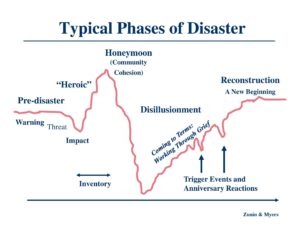By Rose O. Sherman, EdD, RN, NEA-BC, FAAN
Nurse leaders are struggling with staff emotional reactions to the COVID crisis. Reports of negativity, incivility, bullying, and tribalism are on the increase. Nurses openly criticize their leaders. I am often asked why this is happening now.
Maybe, we are looking at the experience through the wrong lens. If you view COVID as a healthcare disaster, the emotions we are seeing make more sense. Experts who train health workers to respond to natural disasters remind us that a disaster’s human response comes in phases. Through extensive study, researchers have developed a model that outlines responses at each phase.
Phase One – is the pre-disaster phase characterized by fear and uncertainty. The staff feels vulnerable. With COVID, this would be the early period of late February to mid-March when warnings around the COVID virus began surfacing in the United States. We watched what was happening in Asia and Europe. There were stress and anxiety about what the impact would be in the US.
Phases Two and Three – are the impact and heroic phases. With COVID, this happened in March, April, and early May. Nursing staff and leaders were running on adrenaline as they confronted an unpredictable enemy. Healthcare workers became heroes celebrated with pot-banging, free food, and fire truck salutes.
Phase Four – is the honeymoon phase when disaster relief becomes more available. With COVID, this happened in May, June, and July. PPE and ventilators became more available. There was hope that a vaccine was on the horizon, and life would return to normal soon. Municipalities moved from lockdown, and summer vacations were planned.
Phase Five – is the disillusionment phase. This is the phase that we have been in for the last 3 months, and it has been hard. In this phase, disaster experts tell us that optimism moves to discouragement. People become tired of the changes that the disaster has brought to their lives. They react with negativity, and stress begins to take its toll. Some will deny what is happening. Everyone begins to work through their grief, recognizing that life has changed, and there are losses. Staff productivity declines. This can take months or sometimes years.
Phase Six – is the recovery phase, and there is a sense of rebuilding a new normal. Anniversaries of the event are celebrated and, for some, trigger strong emotions.
Mental health experts remind us that disasters have a physical, cognitive, behavioral, and emotional impact. The anxiety, fear, and stress we see in the healthcare workforce and population are not unusual. Anger and negativity are normal. Grief is a prevalent emotion. A lack of empathy can also emerge. Many will need mental health support or crisis counseling to move to Phase 6 successfully. We should be using resources like those below from FEMA and the Center for Mental Health Services. We need to more effectively plan our professional response to the mental health challenges we now see.
Read to Lead
Department of Health and Human Services, SAMHSA. A training manual for mental health and human services workers in major disasters 2nd edition. Training Course for Mental Health Post Disaster
Don’t let nurse leaders in your organization go without development. Virtual programs include Nurse Leader Coaching, Coaching Staff to Promote Resilience and Leading Teams in Turbulent Times, or schedule your customized Nuts and Bolts of Nursing Leadership Virtual Workshop taught by experts for either new or experienced leaders. Nuts and Bolts Flyer
Read Rose Sherman’s book available now – The Nurse Leader Coach: Become the Boss No One Wants to Leave
© emergingrnleader.com 2020



 LinkedIn
LinkedIn Instagram
Instagram